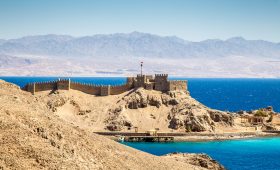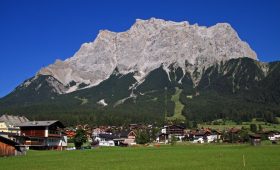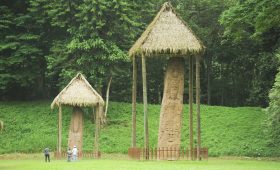Waw an Namus: An Oasis in Libya
Location and Natural Beauty
Waw an Namus, also known as Uaw en Namus or Wau-en-Namus, is a remote volcanic crater located in the eastern Fezzan region of Libya, within the vast Sahara Desert. The name translates to “Oasis of Mosquitoes,” referencing the small lakes around the crater that attract numerous mosquitoes. The landscape is striking, with a 100-meter-deep, 4-kilometer-wide caldera surrounded by dark tephra deposits that contrast sharply with the bright desert sands. This unique geological feature creates a visually stunning environment.
Historical Significance
While Waw an Namus is uninhabited today, it holds historical significance. Ancient graves have been discovered in the area, suggesting that it was once visited by herders and hunters. The site may have also served as a source of raw materials for early civilizations. Despite its remote location, the crater’s historical artifacts provide a glimpse into the past human presence in this part of the Sahara.
Best Time to Visit
The ideal time to explore Waw an Namus is during the cooler months, from November to February. During this period, temperatures range from 20 to 25 degrees Celsius, making it more comfortable for exploration. The summer months should be avoided, as temperatures can exceed 40 degrees Celsius, posing challenges for travelers.
How to Get There
Reaching Waw an Namus requires careful planning due to its remote location and the ongoing Libyan Civil War, which can complicate travel. The most common route is to fly into Tripoli International Airport. From there, travelers can arrange a private tour or hire a local guide familiar with the region. The caravan route between Kufra and Sebha also passes by the volcano, offering another potential access point.
Local Transportation
Once at Waw an Namus, a 4×4 vehicle is essential for navigating the rugged terrain, which includes sandy dunes and rocky paths. Alternatively, travelers can experience traditional Bedouin transport by joining a guided camel trek, providing a unique way to explore the area.
Exploring the Oasis
Inside the caldera, visitors will find three small lakes and additional water bodies forming a semicircle around the central cone. These lakes, some with red hues, create a multicolored appearance against the surrounding desert. The lakes are groundwater-fed, with freshwater springs nourishing them, although they can dry up seasonally. The largest lake covers 0.146 square kilometers and reaches a depth of 12.5 meters.
Activities and Adventures
Waw an Namus offers opportunities for adventure, such as hiking up the crater walls for panoramic views or exploring the caldera’s unique geological features. While swimming or snorkeling might be tempting, the lakes are saline and warm, which may not be ideal for these activities. The presence of mosquitoes is another consideration for visitors.
Local Culture and Hospitality
Although the area is uninhabited, the surrounding regions are home to Bedouin communities. Interacting with these communities can provide insights into their rich cultural heritage and traditional way of life. However, logistical challenges and the current political situation in Libya may limit these interactions.
Summary of Facts
- Waw an Namus is a volcanic crater located in the eastern Fezzan region of Libya.
- The crater features a 100-meter-deep, 4-kilometer-wide caldera with dark tephra deposits.
- Ancient graves indicate historical human presence in the area.
- The best time to visit is from November to February.
- Access is typically via Tripoli International Airport, with local guides recommended.
- Transportation options include 4×4 vehicles and camel treks.
- The caldera contains three small lakes with varying salinity and color.
- Activities include hiking and exploring the unique geological landscape.
- Interacting with nearby Bedouin communities offers cultural insights, though logistical challenges exist.




